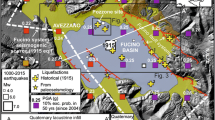Abstract
The eastern shore of Lake Van was shaken by a powerful earthquake (M w 7.2) on October 23, 2011. The epicenter of the earthquake was located at about 30 km north of the Van Province, which is one of the main cities in the Eastern Anatolia. The Van Province and particularly its largest district Ercis were adversely affected by the earthquake, and unfortunately, a total of 600 people lost their lives. Besides severe constructional damages and building collapses, ground deformations were widespread at many locations nearby the Lake Van and Karasu River floodplain. Numerous sand boils and lateral spreading cracks were observed at the left and right embankments of the Karasu River, which is one of the major streams in the region. In this study, field observations on liquefaction and lateral spreading features triggered by the M w 7.2 Van earthquake are initially presented. Then, the results of subsurface investigations including trial pits, drillings and geophysical surveys on specific large-scale sand boils are explained. Subsequently, liquefaction back-analysis is performed considering the gathered subsurface data. The analysis indicates that the liquefaction occurred in a shallow zone with approximately 4 m thickness in the investigated area. The Liquefaction Potential Index method reveals high liquefaction potential for the analyzed sand boil location. In addition, the effect of cap soil thickness on liquefaction is once more validated by this case.





















Similar content being viewed by others
References
Akin MK, Kramer SL, Topal T (2011) Empirical correlations of shear wave velocity (Vs) and penetration resistance (SPT-N) for different soils in an earthquake-prone area (Erbaa-Turkey). Eng Geol 119:1–17
Akyuz S, Zabci C, Sancar T (2011) Preliminary report on the 23 October 2011 Van earthquake. Istanbul Technical University (ITU) report
Alan H, Bozkurt E, Caglan D, Dirik K, Ozkaymak C, Sozbilir H, Topal T (2011) Van earthquakes (Tabanli-Edremit) report, November 2011. Chamber of Geological Engineers, Publication No. 110, Ankara (in Turkish)
Aydan O, Ulusay R, Kumsar H, Konagai K (2012) Site investigation and engineering evaluation of the Van earthquakes of October 23 and November 9, 2011. Japan Society of Civil Engineers, JSCE, p 148 (http://committees.jsce.or.jp/report/system/files/)
Committee of Earthquake Engineering (1985) Liquefaction of soils during earthquakes. National Academy Press, Washington, p 240
DEMP (2011) About Van earthquake. http://www.afad.gov.tr. Accessed 15 Dec 2011
EduPro Civil Systems (2003) Inc. ProShake v 1.12. Ground response analyses program. Sammamish, Washington
Emre Ö, Duman TY, Özalp S, Elmacı H (2011) Field observations after 23 October 2011 Van earthquake and preliminary evaluations about the source fault. Active Tectonics Research Group, General Directorate of Mineral Research and Exploration publications, Ankara (in Turkish)
Gates AE, Ritchie D (2007) Encyclopedia of earthquakes and volcanoes. Infobase Publishing, USA, p 346
Groshong RH (1999) 3-D structural geology: a practical guide to surface and subsurface map interpretation. Springer-Verlag, Berlin, p 327
Idriss IM, Boulanger RW (2004) Semi-empirical procedures for evaluating liquefaction potential during earthquakes. Proceedings 11th ICSD and 3th ICEGE, 7-9 January 2004, UC Berkeley, California, USA
Idriss IM, Boulanger RW (2006) Semi-empirical procedures for evaluating liquefaction potential during earthquakes. Soil Dyn Earthq Eng 26:115–130
Ishihara K (1985) Stability of natural deposits during earthquakes. Proceedings of the 11th international conference on soil mechanics and foundation engineering, vol 1. A.A. Balkema, Rotterdam San Francisco, pp 321–376
Iwasaki T, Tokida K, Tatsuoka F, Watanabe S, Yasuda S, Sato H (1982) Microzonation for soil liquefaction potential using simplified methods. Proceedings of the 3rd international conference on microzonation, Seattle, 3, pp 1310–1330
KOERI (2011) Recent earthquakes. http://www.koeri.boun.edu.tr/. Accessed 24 Oct 2011
METU/EERC (2011) Field observations on seismic and structural damage after 23 October 2011 Mw 7.2 Van earthquake. Ankara, Report No. METU-EERC 2011-4, p 76
Ozkaymak C, Sozbilir H, Bozkurt E, Dirik K, Topal T, Alan H, Caglan D (2011) Seismic geomorphology of October 23, 2011 Tabanlı-Van earthquake and its relation to active tectonics of East Anatolia. J Geol Eng 35(2):175–200 (in Turkish)
Sonmez H, Gokceoglu C (2005) A liquefaction severity index suggested for engineering practice. Environ Geol 48:81–91
Sonmez B, Ulusay R, Sonmez H (2008) A study on the identification of liquefaction-induced failures on ground surface based on the data from the 1999 Kocaeli and Chi-Chi earthquakes. Eng Geol 97:112–125
Sumengen M (2008) Turkish geological maps in 1:100.000 scale, No. 65, Van—K50 sheet. General Directorate of Mineral Research and Exploration publications, Ankara (in Turkish)
Taskin B, Sezen A, Tugsal UM, Erken A (2012) The aftermath of 2011 Van earthquakes: evaluation of strong motion, geotechnical and structural issues. Bull Earthq Eng. doi:10.1007/s10518-012-9356-9, Published online 11 May 2012
Ulusay R, Kumsar H, Konagai K, Aydan O (2012) The characteristics of geotechnical damage by the 2011 Van-Erciş earthquake. Proceedings of the international symposium on engineering lessons learned from the 2011 Great East Japan Earthquake, 1–4 March 2012, Tokyo, Japan, pp 1926–1937
USGS (2011) Earthquakes. http://earthquake.usgs.gov/earthquakes/. Accessed 24 Oct 2011
Acknowledgments
The authors would like to thank Prof. Dr. Peyami Battal, the rector of Yuzuncu Yil University, for his support during the field studies. Libra Soil Mechanics Laboratory deserves thanks for the essential laboratory tests. Dr. Samad Joshani-Shirvan is acknowledged for his comments on the use of language. The authors are also grateful to the anonymous reviewers’ valuable remarks and suggestions.
Author information
Authors and Affiliations
Corresponding author
Rights and permissions
About this article
Cite this article
Akin, M., Ozvan, A., Akin, M.K. et al. Evaluation of liquefaction in Karasu River floodplain after the October 23, 2011, Van (Turkey) earthquake. Nat Hazards 69, 1551–1575 (2013). https://doi.org/10.1007/s11069-013-0763-2
Received:
Accepted:
Published:
Issue Date:
DOI: https://doi.org/10.1007/s11069-013-0763-2




